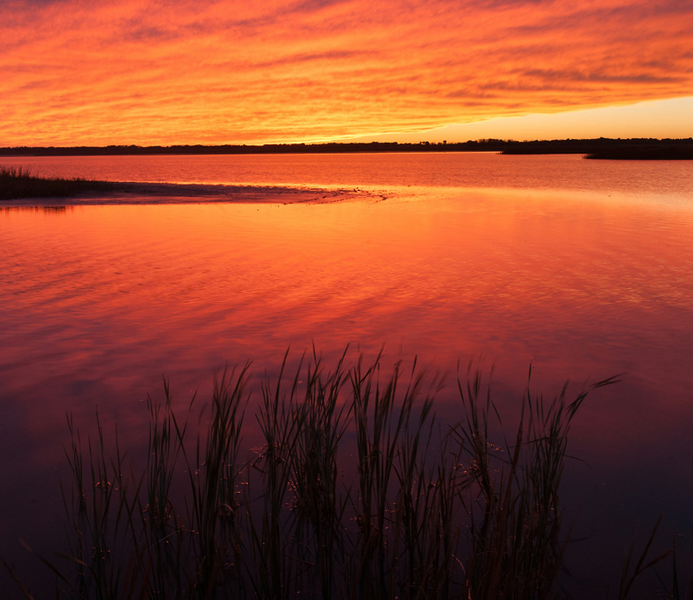
By AJ DOME
Kansas Reflector
Officials say a new agreement benefits both a national wildlife refuge and local agriculture producers in central Kansas, and it involves the extraction of several invasive plant species in the area along with water augmentation for a local creek.
Water usage at the 22,135-acre Quivira National Wildlife Refuge in Stafford, Rice and Reno counties has been in discussion among interested parties for nearly a decade, beginning with a water impairment notice filed by the U.S. Fish and Wildlife Service and the Kansas Department of Agriculture.
Meetings were held in St. John last year over the future of water in the area. Managers of the refuge met with local ag producers, as well as members of KDA and the Big Bend Groundwater Management District 5, over the course of several months. On July 25 of this year, the stakeholders signed a memorandum of agreement.
“It’s not the final agreement,” said Mike Oldham, manager of the Quivira refuge. “It is something which will lead to a much larger legal document, as the groundwater management district is in the process of doing more things for conservation.”
The state engineer oversees water right distribution and evaluation. The discussions over who was first in right to the water involved Oldham, as well as local stakeholders and political leanings from Sen. Jerry Moran.
Moran said he shared the water rights dispute with U.S. Fish and Wildlife director Aurelia Skipwith, explaining the need for farmers and ranchers to be able to utilize groundwater in the basin.
“The agreement reached works to meet the needs of both local agricultural producers and the wildlife refuge by augmenting the streamflow of Rattlesnake Creek, and encouraging voluntary conservation efforts,” Moran said.
Water augmentation makes up a good portion of the plan, as well as retiring water rights out of sensitive areas of the district and moving some of those water rights to less sensitive areas. Oldham said the removal of invasive tree species will also help. He said they are currently trying to control four specific species of tree.
“We don’t want them to creep in and basically invade the grassland habitat we have,” Oldham said.
Salt cedar, or tamarisk, is the biggest invasive offender. Oldham said he came from the Colorado River, where the plant grows into a full-size tree, whereas in Kansas it grows more like a problematic shrub.
“They grow a lot bigger in a warmer climate,” Oldham said. “The roots go fairly deep and can tap into more water reserves.”
Oldham said these tamarisk plants grow out and reaching for water where they can, and they can certainly out-compete Kansas’ native species of trees for water resources. Mitigation tactics for the salt cedar and other invasive trees will include excavation from the earth, roots and all. When that option is not available, workers will chop the tree off at the stump, then kill the stump with a federally-approved herbicide.
“You have to look at each tree, how it grows and when it grows,” Oldham said. “If you look at salt cedar, it’s got a root crown, which sits about 18 inches below root surface. Basically, you’re chopping down the top and it’ll root-sprout and clone itself. A lot of these species require multiple treatments.”
The biggest portion of the plan involves augmenting Rattlesnake Creek close to the refuge by pumping groundwater from a relatively untapped basin nearby. Jim Butler, senior geohydrology scientist at the Kansas Geological Survey, says the stream flow into the refuge would increase under that scenario, benefitting ag producers and the refuge, but there would not necessarily be any water savings or conservation.
“The water savings from vegetation removal are going to be short term and would be difficult to quantify or recognize using data,” Butler said. “The major reason for the low flows coming into the refuge is the pumping of groundwater. Water use by vegetation is vastly overwhelmed by that.”
Butler said there is a wide range of opinions on whether that plan can actually meet the needs of the refuge for the long term. Butler used an example of a project he worked on previously along the Cimarron River near Ashland, in which he said a large swath of salt cedar was removed. Scientists then looked at the impact on shallow groundwater.
“The impact was short-lived, as other plants moved in to fill the empty niche,” Butler said. “The most positive impact was rangeland restoration.”
Butler said it will take “constant vigilance” to keep the invasive species from moving back in. Oldham said, as far as the refuge goes, it is an ongoing thing.
“I don’t think you ever get to the point where you remove your last invasive tree and say, ‘I’m done,’ ” Oldham said. “You’re always continuing the control.”
Oldham said refuge management is going for a balanced approach.
“The thing we have to remember: There’s still value of that invasive tree species, whether to migratory birds or other wildlife,” Oldham said. “Maybe it’s not a good thing to remove 100% of those trees. Doing it little by little is a good thing, but it’s a balancing act. We don’t want to do too much at one time.”
AJ Dome is an award-winning journalist and broadcaster from southwest Kansas. When he’s not writing, he’s helping people receive pandemic unemployment benefits for the Kansas Department of Labor.



